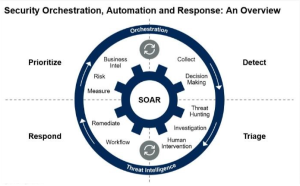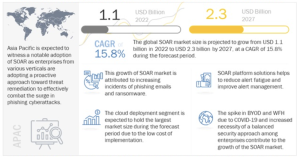“a Forecasts by Acumen Research and Consulting indicate that the security orchestration automation and response market will expand at a CAGR of 15.7% between 2018 and 2032, with a final target valuation of $5.1 billion.”
As it is a key player in Cybersecurity world, SOAR combines orchestration, automation, and response methods to strengthen the protection measures. This articles looks at the most recent developments and enhancements in the SOAR industry, focusing on how it impact and changed the cybersecurity operations.
SOAR Overview
SOAR (security orchestration, automation and response) is a stack of compatible software programs that enables an organization to collect data about cybersecurity threats and respond to security events with little or no human assistance. The goal of using a SOAR platform is to improve the efficiency of physical and digital security operations.

Development of SOAR
SOAR technology is still going strong with its constant evolution!
Between 2023 and 2024, the global security orchestration automation and response (SOAR) industry is expected to have a significant growth, and more likely that the market will expand due to the rising acceptance of strategies by major players and the constant market growth.
And due to the technological improvements, planning and response capabilities, security specialist can now manage complex threats more efficiently and accurately than ever, and by the end of 2024, SOAR will have an undergone continuous improvement to meet the changing demands and obstacles of the cybersecurity industry.

The Most expected SOAR Market Trends of 2024
It is expected that the following developments will re-shape how businesses utilize SOAR to protect their digital assets:
The integration with AI and ML:
To better detect and respond to threats, SOAR systems are increasingly using AI and ML algorithms.
22% of the companies are actively working to incorporate AI into a broad range of technological products and company processes [1].
These advancements in technology allow SOAR systems to better detect trends, outliers, and possible dangers by evaluating massive volumes of security data in real-time, enhancing overall security.
Applications beyond the normal security operations:
By end of 2024, SOAR systems will have expanded their use cases to cover more ground than conventional safety incident response. This category includes IT operations, risk administration, and managing compliance. The value and usability of SOAR are maximized when its uses are diversified, making it an important component of corporate operations.
Emphasize Hybrid and Cloud-Native Setups
Cloud computing and hybrid infrastructures are becoming increasingly common, and SOAR platforms are adapting to meet the needs of these new settings.
“After reaching USD 480 billion in 2022, the worldwide cloud computing industry is projected to reach over USD 2297.37 billion by 2032, expanding at a CAGR of 17% (Precedence Research)”.
Due to this trend, organizations may now expand their security processes across varied infrastructure landscapes, which entail establishing native integrations with cloud-based services and guaranteeing compliance with hybrid architectures.
Prioritization of Easy-to-Use Interfaces and Processes
In 2024, SOAR suppliers are placing a greater emphasis on usability and simplicity of use. Making SOAR systems accessible to various individuals inside companies, user-friendly interfaces, and simple processes accelerate their implementation and operation.
Adoption rates are increased, and SOAR installations are generally more effective due to this emphasis on usability.
The Need to Integrate Threat Intelligence Is Growing
Integration of current and pertinent threat intelligence into SOAR systems is becoming increasingly important as the sophistication of cyber-attacks continues to grow. Incorporating credible threat intelligence streams allows SOAR systems to streamline replies based on the most recent findings, prioritize warnings, and enhance incident data.
This integration helps firms avoid new threats by bolstering the proactive aspect of safety processes.
Upcoming Shifts in the SOAR Environment
In 2024, the SOAR environment will experience significant changes to adapt to the changing needs of cybersecurity:
- Powerful automated features: SOAR platforms’ increasingly advanced automated features make rapid reaction to threats possible, which minimizes user interaction.
- Connecting to DevSecOps methods: By integrating into DevSecOps pipelines, SOAR solutions make it easier for teams working on expansion, security, and management to collaborate. Integrating security into the software production lifecycle enhances the entire security posture of apps and infrastructure.
- Establishing a Zero Trust Policy: By Zero Trust principles, which state that resources should never be implicitly trusted, SOAR processes are structured accordingly. Irrespective of the user’s locale or system, this strategy strengthens security by continually monitoring and confirming access requests.
- Prioritization of efficiency and scalability: SOAR systems put performance and scalability first to handle massive deployments and security activities. That way, even in complicated and ever-changing settings, businesses can handle security crises gracefully and efficiently.
- Meeting the needs of regulators and adhering to regulations: Features built into SOAR solutions make it easier for businesses to meet all of the rules and regulations that pertain to compliance. To help with audit preparation and compliance management, there are features like built-in reporting and automatic audit trails.
Conclusion
In the rapidly changing world of cybersecurity in 2024, SOAR is a shining example of innovation!
Its main selling point is the capacity to improve efficiency, tighten security, and simplify processes. Organizations face more complex cyber threats, and SOAR is crucial in protecting themselves. Security teams can confidently and quickly manage the intricacies of modern cybersecurity with the help of SOAR, which integrates enhanced automation, orchestration, and responsive mechanisms.
Future success in protecting digital assets, reducing risk, and being resilient in the face of new threats will depend critically on the widespread use of SOAR. Therefore, firms who want to remain ahead in the never-ending fight against cyber threats must embrace SOAR.




